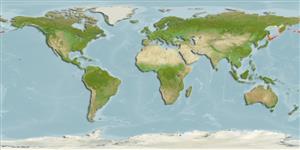Environment: milieu / climate zone / depth range / distribution range
Ecología
marino demersal; rango de profundidad 14 - 99 m (Ref. 51666). Polar
Distribución
Países | Áreas FAO | Ecosistemas | Ocurrencias, apariciones | Point map | Introducciones | Faunafri
Northwest Pacific: southern Kuril Islands, southwestern Okhotsk Sea, Tatar Strait to Peter the Great Bay and Moneron Island, Japan Sea.
Tamaño / Peso / Age
Maturity: Lm ? range ? - ? cm
Max length : 40.0 cm TL macho / no sexado; (Ref. 56557); common length : 20.0 cm TL macho / no sexado; (Ref. 56557)
Occurs in coastal waters (Ref. 51666).
Life cycle and mating behavior
Maturities | Reproducción | Spawnings | Egg(s) | Fecundities | Larva
Sokolovskaya, T.G., A.S. Sokolovskii and E.I. Sobolevskii, 1998. A list of fishes of Peter the Great Bay (the Sea of Japan). J. Ichthyol. 38(1):1-11. (Ref. 27683)
IUCN Red List Status (Ref. 130435)
Threat to humans
Harmless
Human uses
Herramientas
Special reports
Download XML
Fuentes de Internet
Estimates based on models
Phylogenetic diversity index (Ref.
82804): PD
50 = 0.5312 [Uniqueness, from 0.5 = low to 2.0 = high].
Bayesian length-weight: a=0.01000 (0.00244 - 0.04107), b=3.04 (2.81 - 3.27), in cm total length, based on all LWR estimates for this body shape (Ref.
93245).
Nivel trófico (Ref.
69278): 3.7 ±0.2 se; based on size and trophs of closest relatives
Resiliencia (Ref.
120179): Muy bajo, población duplicada en un tiempo mínimo superior a 14 años (Preliminary K or Fecundity.).
Fishing Vulnerability (Ref.
59153): Low to moderate vulnerability (30 of 100).
